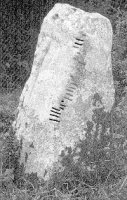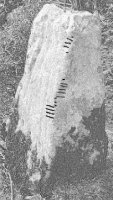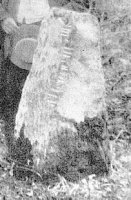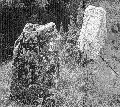According to Macalister, PRIA 32, 1914, 139, the stone "was found by one Mr. Igoe, of the Ordnance Survey, and by him communicated to Dr. Douglas Hyde". Macalister visited the site "without delay" together with Dr. E.C. Quiggin, of Cambridge; he describes the stone as standing "in a copse on the left-hand side of the road leading from Belnagare to Rathcroghan", together with a second stone, both "evidently" (thus in PRIA 14) or "presumably" (thus in CIIC) marking a grave".
Meanwhile (1978/1996), the surroundings have changed in the way that the copse has been cultivated and forms a field; it obviously belongs to the nearby farmhouse called "The Long Acre". The location is not as close to the (national) road as Macalister's description suggests, but it can be easily accessed from the first road turning to the left after leaving Bellanagare.
Size according to Macalister, PRIA 32, 1914, 139 and CIIC: 3'7" x 1'4" x 1'8".
Published photographs:
- Macalister, PRIA 32, 1914, Pl. XV, Fig. 1.
The stone was not included in Macalister, Epig..
CUNOVATO
The V is "faint", the end of the inscription "fractured"; after the -O, there were possibly a "few more vowel notches lost", but the inscription is probably complete. -VATO is "evidently" the genitive of v¦tis "a prophet". The vowel o of the first compound member "is certain"; CUNO- otherwise appears in South Britain only, as against -CUNA- in Ireland: cp. CUNA-CENA {199: Coolmagort}, GLASI-CONAS {159: Ballintaggart}; {252: Gurrane}, ASSI-CONA {134: Kealvaugh More}, CUNA-NETAS, CUNALEGEA {275: Drumlohan}, NETA-CUNAS {105: Coolineagh}; {261: Priesttown}; {278: Drumlohan}; from the Isle of Man: CUNA-MAGLI {501: Arbory}.
CUNOVATO
The N is "faint". There is a "fracture" at the end of the inscription, which however "seems to be complete".
CUNOVATO[?
Because of the fracture at the end, an original CUNOVATO[S] seems possible. If so, the inscription would be archaic, dating from the 5th century. - [p. 141 s.v. CUNOVATO:] The compound vowel -O- is due to the following labial (V = bilabial w). [Cp. Hamp, EC 6, 1953-54, 284, whom Korolev quotes under IVODACCA only.] *Kunowat¨s fell together with nom. Cunanetas in the course of the Irish sound history: > Cunovato > *Conwatho > Connatho, Connada. If it was an i-stem originally, it belonged to fÿith < *w¦tis `prophet, seer', i.e. `seer captured by wolf's grim = seer in ecstasy?' If it was a stem in -u-, it belonged to fÿth, Cymr. gwawd, Celt. *w¦tu, meaning `seership, aphorism, prophecy, wisdom; topic; ground, basis, motive, target', Cymr. `poetical work, poem'; i.e. `wolf's prophecy, wolf's wisdome'? Cp. Lat. v¦t§s, Goth. wods etc.
Reading Gippert (1978/1996):
 Angle-up:
Angle-up:
C(UNA)[.](AT)[O
îì(äêéâ)[.](âí)[ã
ëëëë(ââ)[â](çççççâ)[.ç.](âë)ëëâ[â
No further marks were recoverable in 1978. By 1996, the  angle seems to have suffered more levelling so that the
angle seems to have suffered more levelling so that the  B-strokes of the N have become even harder to trace. Of Macalister's reading, neither the medial O nor his V could be ascertained. His
B-strokes of the N have become even harder to trace. Of Macalister's reading, neither the medial O nor his V could be ascertained. His  photograph (in PRIA 32) is not sharp enough to show whether the state of this part of the inscription was better at his time.
photograph (in PRIA 32) is not sharp enough to show whether the state of this part of the inscription was better at his time.
Like this, all assumptions concerning o as a composition vowel in the present name lose weight. Besides Macalister, this concerns Hamp, EC 6, 1953-54, 284, who points to IVODACCA [Grange, 269] and CUNOVATO which he believed to show that "in the presence of w the composition-vowel had a somewhat more round value". A similar view was noted before by Mac Neill, Cloonmorris (JRSAI 39, 1909), 135 [cf. {2: Cloonmorris}].
Last changes of this record: 15.04.97
Copyright Jost Gippert, Frankfurt a/M 1996. No parts of this document may be republished in any form without prior permission by the copyright holder.  Angle-up:
Angle-up: angle seems to have suffered more levelling so that the
angle seems to have suffered more levelling so that the  B-strokes of the N have become even harder to trace. Of Macalister's reading, neither the medial O nor his V could be ascertained. His
B-strokes of the N have become even harder to trace. Of Macalister's reading, neither the medial O nor his V could be ascertained. His  photograph (in PRIA 32) is not sharp enough to show whether the state of this part of the inscription was better at his time.
photograph (in PRIA 32) is not sharp enough to show whether the state of this part of the inscription was better at his time.










